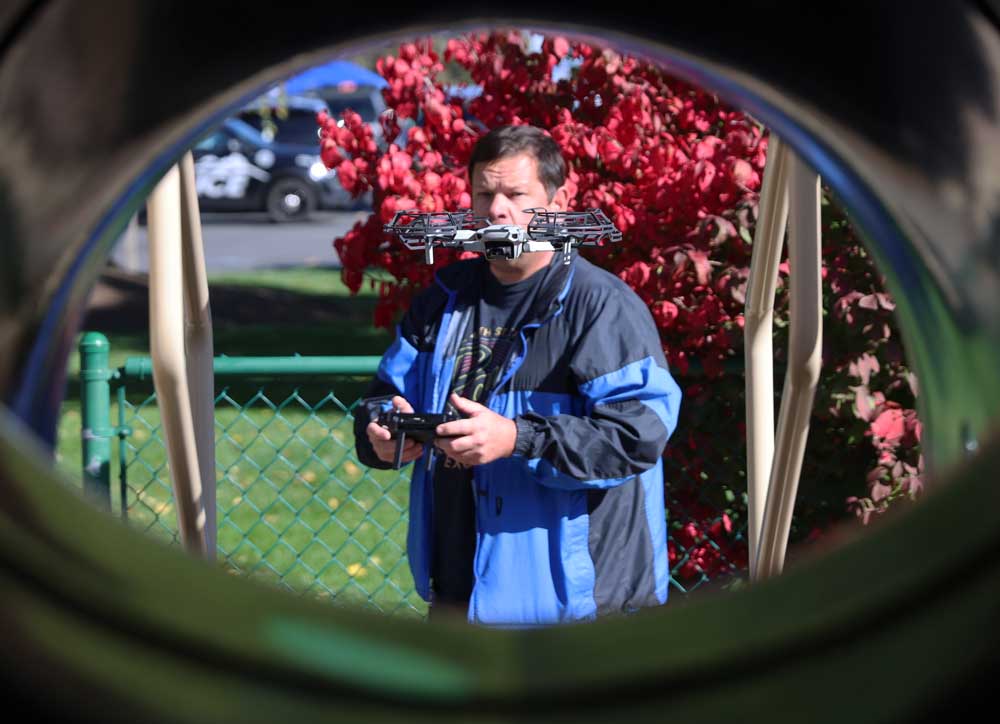Bzzz! Police drones buzz Bend during conference
Published 5:00 am Friday, October 8, 2021

- West Sacramento police officer Cameron Simpson flies a drone in a playground-structure obstacle course during the conference.
The Autel Dragonfish buzzed a little louder than the rest of the drones as it ascended Thursday above the Christian Life Center so it could join several others for automated passes in the skies over Bend.
The fixed-wing drone, which resembles a hobbyist’s remote controlled airplane, can take off like a helicopter and fly forward like a plane at nearly 70 mph. It retails for more than $100,000 and resembles a military drone, so locals could be forgiven for thinking they were being watched in real time. Law enforcement officers were nearby, but it wasn’t a surveillance operation. It was all part of a conference being held in Bend.
This week is the annual conference of the Law Enforcement Drone Association, a Tigard-based nonprofit with a mission of spreading and standardizing drone practices across police agencies. Forty-three agencies from 12 states are represented at the gathering, which ends Friday.
With reliable sunshine and a good local knowledge base, Bend is a natural setting for a police drone conference, according to Doug Seirup, the association’s director and a deputy with the Benton County Sheriff’s Office. “It’s kind of a perfect, beautiful place to do this,” he said. “There are lots of applications to use drones and lots of officers here who know how to use them.”
In basic terms, drones help a person see an area from above. Police use them primarily in suspect and missing person searches and photographing crash and crime scenes.
Ground-based robots have been in use by police agencies for decades for bomb disposal and other tasks. But there was a sudden uptick in police use of aerial drones around 2016 with the release of the DJI Mavic, a drone popular with civilians that also proved useful to police forces.
Bend Police Department’s drone program began that year with a single drone. Today, there are nine officers with the specialization and a small fleet of various aircraft, and that initial drone is an antiquated relic, said Sgt. Tom Pine, who has overseen the Bend Police drone program since 2016.
Police drone pilots receive no bump in pay — though some agencies provide added compensation for drone pilots — but officers still line up for training to become drone pilots, Pine said.
Today, most police agencies in the state have at least one drone, and if they don’t own one, they’re at least open to using the technology.
“I haven’t run into anyone who wasn’t at least receptive to our help when they’ve needed it,” Pine said.
In Deschutes County, they’ve been used to help locate residents in a mental health crisis and get a better look at people who have barricaded themselves somewhere and are refusing police commands.
“Police use drones for the same things they use helicopters, only the barrier to entry is much, much lower for agencies that don’t have millions of dollars to spend on a helicopter,”’ said Brandon Karr, a drone association board member and a patrol officer with the Pearland Police Department in Pearland, Texas. “We use these platforms to make safer decisions for everyone involved.”
The latest state-of-the-art drone view involves thermal imaging. There was talk at the conference of a future with drones as first responders. In 2018, Chula Vista, California, began a pilot program deploying a drone on 911 calls. Karr said preliminary data from the program shows a drone beats the patrol officer to the scene by an average of three minutes.
Today, a base model DJI Mavic Mini, capable of simple indoor missions, runs around $400. On the other end of the tech spectrum is the Dragonfish. A popular model with midsized police departments, the DJI Matrice, runs around $30,000. Officers attending the conference reported federal and state grants were often a source of funding.
In Oregon, drones may be used by police for only specific purposes, and surveillance is not one. They can be used in an emergency but require a reason to be aloft, like searching for someone. Many other cases require a search warrant. The Federal Aviation Administration and Oregon law require regular reporting of every flight taken by a police drone, including training exercises.
Performing drone operations is becoming a specialization in law enforcement akin to handling a police dog. And like being canine handlers, drone operators must maintain their equipment and stay proficient. The changing technology and technical skill required combine to make drone piloting a “perishable” skill, one requiring regular training.
Oregon Postal Inspector Adam Sale said he’s used his office’s drones in several recent major narcotics investigations, investigating fentanyl, heroin and methamphetamine traveling through the mail.
Postal inspectors are federal officers who work for the U.S. Post Office investigating crimes related to the mail. Sale oversees eight other inspectors in Oregon and southwest Washington who often assist other agencies, notably the U.S. Drug Enforcement Administration and FBI.
“Our agency is very open to mutual aid, so if other agencies call for assistance, my office is very happy to share it and spread the word about the drone program,” he said.
The Postal Inspection Service has a broad and ever-evolving role, making a pivot to drones a natural step, Sale said. Sale uses his office’s drones to fly to properties as part of pre-mission planning before searches warrants are executed.
Sale’s office focused on expanding its drone program during the pandemic.
“Since we weren’t able to do other things, it allowed us to focus on this program and do some training and make purchases,” Sale said. “And it’s really taken off — no pun intended.”








